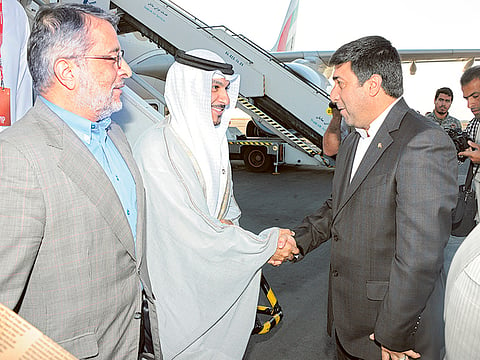Emirates may speed up Iranian expansion following nuclear deal
Emirates is considering flying to more destinations in Iran

Dubai: Emirates is looking to add more flights to Iran, including to new destinations, a senior executive told Gulf News on Tuesday, the day it launched flights to Mashhad, the country’s second biggest city.
The airline is interested in expanding its reach in Iran beyond its current four daily flights to Tehran, the capital, and five new weekly flights to Mashhad, its 146th global destination, now that sanctions are expected to ease.
“[This] will give us more opportunity to look at other points” and look into increasing capacity on existing routes, Shaikh Majid Al Mualla, Emirates Divisional Senior Vice-President of Commercial Operations Centre, told Gulf News on board the inaugural flight to Mashhad.
Iran’s economy is expected to surge from early next year when international sanctions begin to lift under the nuclear agreement the country reached with the United States and other world powers this summer.
“Iran has a huge potential,” Shaikh Majid said.
Under sanctions, Emirates flew half a million passengers to and from Iran in its last financial year that ended March 31, 2015. This will increase by at least 10 per cent on the Tehran route this year in addition to Mashhad traffic, Shaikh Majid said. “We are very optimistic [now that] the sanctions are going to be lifted,” he said.
It has flown 7 million passengers since it first launched flights to Tehran in 1990.
Shaikh Majid did not state when and where the airline could expand to in Iran. And while he said Emirates was “looking into” new destinations, he said there would be no “overnight” changes once the sanctions do go.
“We are waiting for the right opportunity,” he said.
Emirates’ new service to Mashhad brings its total weekly flights to Iran to 33, its limit under the current bilateral agreement between the UAE and Iran. This means Emirates will most likely need to wait for government-to-government talks to expand the bilateral agreement before it can add further flights. “The sooner [a new agreement is reached], the better,” Shaikh Majid said.
Despite the bilateral constraints, Mashhad International Airport is already pushing Emirates for more flights with its Director-General Gasem Zadeh telling reporters he hopes the five weekly service will “be daily very soon.”
Mashhad attracts two million foreigners a year, many Shiite Muslim pilgrims from the Arab world, the Indian Subcontintent and Asia.
Shaikh Majid said there is also scope to add an Airbus A380 service to Tehran, where it flies to four times a day usually with a Boeing 777-300ER (extended range).
Emirates flew the A380, world’s largest passenger jet, to Tehran last September as a one-off.
Emirates also has high expectations for future trade flows in and out of Iran and may add a dedicated freighter service to the country to meet demand if trade volumes do surge, Khalid Mohammad Al Hinai, Emirates’ Vice-President Cargo Commercial for the Middle East, GCC and Iran, said.
In 2014, bilateral trade between the UAE and Iran was Dh97.3 billion according to UAE Ministry of Economy figures cited by Emirates.
Sign up for the Daily Briefing
Get the latest news and updates straight to your inbox



